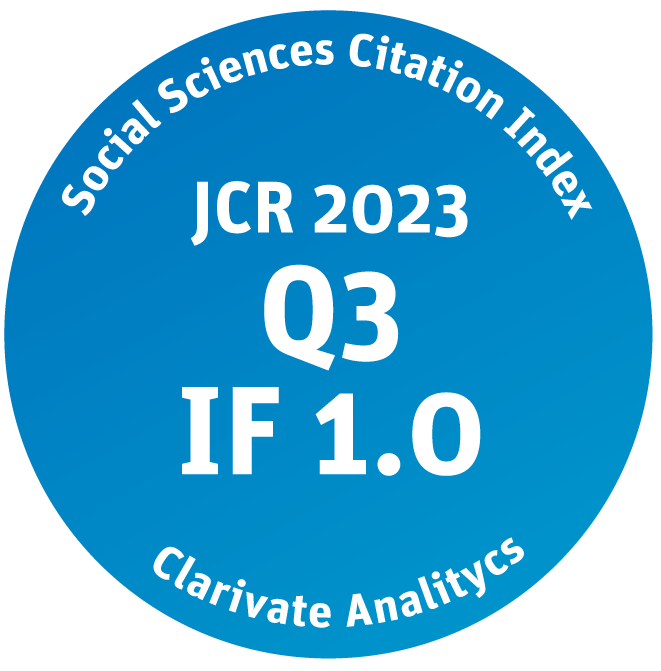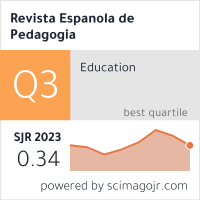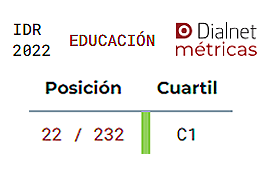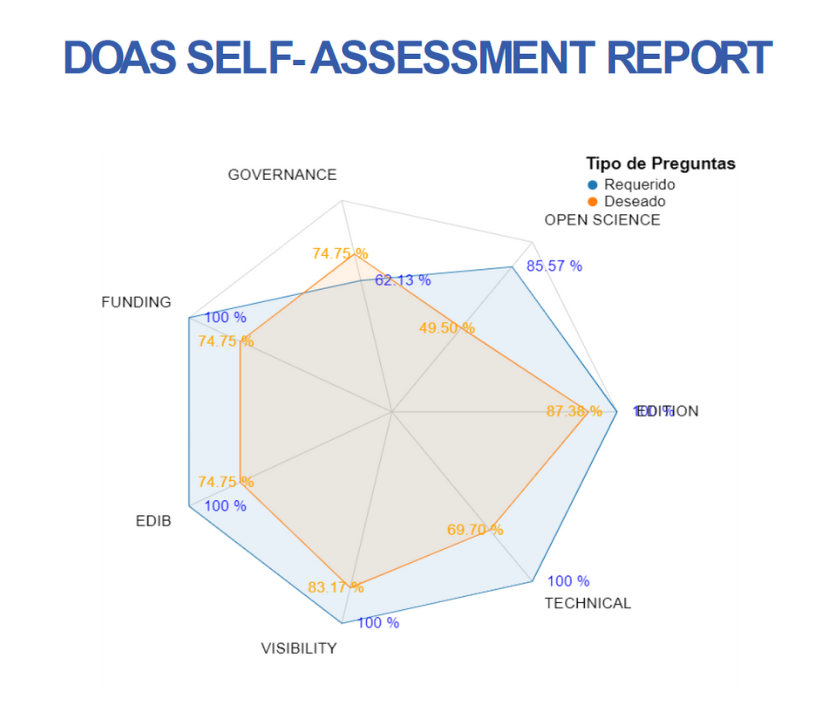Reseña bibliográfica: Gil Quintana, J. (2023). Educación y comunicación en una sociedad postdigital. Investigación documental y análisis de perspectivas. Octaedro. 268 pp.
DOI
10.22550/2174-0909.4123
Abstract
This book, which provides a well-documented overview of communication scenarios and learning environments from an educational-communicative focus, is unquestionably a work of great intellectual and human value. It is required reading for understanding the new digital paradigm shaped by the connection between people, online learning, and technology, understood as a relational factor. In this labyrinth, education and the values that lead to a civic-minded and engaged citizenship will be the great allies to advance decisively in the era of netmodernity in which we find ourselves.
Gil Quintana has a great knowledge of education and communication, and has a long academic career that enables him to position himself with regards to current needs and rigorously address the principal challenges of the post-digital society. This concept “does not seek to describe a life beyond the digital space. It is a question of detailing the current opportunity to explore the consequences of the information or communication society” (p. 63, author’s own translation). This author presents a historical approach to edu-communication framed in a context dominated by technologies. It is no longer easy to separate the analogue arena from the digital sphere. Everything comes together and mixes in the same space–time, creating new modes of participation supported by interdependent networks. In netmodernity, everything is connected.
This author’s new title makes a great effort to explain current frameworks of action and how they oblige us to confront everyday routines from new perspectives, where communication and education come together in a single path. It is a fact that we no longer learn how we did in earlier decades, nor do we communicate in the same ways. The figure of the teacher or instructor has become more complex; the subject and object of education have been transposed. In this reality where technology is an active and immersive part of educational processes, knowledge and critical capacity will be the foundations of an authentic humanist project that can respond to people’s role in the post-digital society.
The analysis of the results of the research that this book contains are set out in seven categories, each of which in turn is structured as a chapter. In addition to these seven chapters, there is an initial one (“Documentary research and analysis of perspectives”) that sets out the methodology used and the starting point of the study. At the end of this chapter, the author synthesises some of the key ideas as a conclusion. This is very useful as, in the great quantity of information that he provides, this final overview helps establish the key concepts of each section. This book is of undoubted academic interest, although it does require prior knowledge some of the principal theories of communication and reference authors in the matter of the history of education and the ability to handle them to enable a better understanding of its very broad itinerary. Some of the theories reviewed in it require a significant grounding in hermeneutics in some points to be able to interpret the classical focusses and how they converge in the more current frameworks in which we are positioned.
Chapter one (“Discipline communication and education: Edu-communication”) covers basic concepts, including information, communication, and digital competences, weaving them into the reality of the ecology of communication, interlearning, connectivism, and endogenous and exogenous educational models. Accordingly, it invites thorough reflection and argues in detail on the importance of media literacy and the need to understand the media “not only as a didactic resource, but also as an object of study, with the aim of creating an analytic outlook” (p. 61, author’s own translation) that critiques what surrounds us.
These initial concepts are integrated in chapter two (“Principles of edu-communication: Interactiveness, participation culture, and dialogic action”), which includes a new typology of prosumers “(EAV [exploited, stalked, and victim of the market], CD [digitally constructed], VE [emotionally linked], MM [digital and analogue dead], and I-I [interacting and interacted]), but also influencers who have positioned themselves in social networks with significant impact and influence at a social level” (p. 93, author’s own translation). These new forms of action open up parallel spaces to those that were previously known and can be in-person, virtual, or hybrid. Therefore, it is a matter of “promoting a communication and education with fewer instructors and more influencers of learning who position themselves before the market as emirecs [emitters/receptors]” (p. 94, author’s own translation).
The third chapter (“Edu-communicative methodological strategy: Media construction of reality through the image”) is constructed from a dual perspective. That is to say, the image as “de-educator” (p. 95) or as an essential tool to introduce knowledge from early childhood. Among other tools, the use of film is considered as a powerful and widely researched educational resource in regards to the impact and effects that it generates from the formative sphere. Chapter four (“Edu-communicative methodological strategy: Social networks”) takes these new learning pathways from the classroom as a model for citizen empowerment.
“Social networks are scenarios for participation, spaces for bidirectional and horizontal communication” (p. 142, author’s own translation).
Chapter five (“Edu-communicative methodological strategy: Gamification”) covers active methodologies from a historical vision and the connection between learning and play from early childhood. As learning scenarios, ludic environments are based on two principal components: “the person’s motivation and commitment to the ludic experience” (p. 144, author’s own translation). Academic interest in this innovative focus underlines its enormous impact on learning, contrasting with more traditional methods that seek student interaction and empowerment. Gamification enables “the creation of a new narrative where the concepts of interacting, sharing, participating, and collaborating connect to one another” (p. 170, author’s own translation).
Chapter six (“Massive and open edu-communicative strategy: sMOOC and tMOOC”) focuses on massive open online courses, which have emerged as an alternative to traditional systems of education. “MOOCs have become established in the second decade of the 21st century as a tool for social change and for the development of active and collaborative learning” (p. 196). The last chapter (“Future edu-communicative perspectives: Learning influencers”), as a conclusion, considers the call for people to participate in free culture, collaborative action, critical pedagogy and the swapping of roles between teachers and students, communality, activism… and the novelty of the concept learning influencer. In relation to it, the author considers its two categories: the role of learning influencer and the IGPEC model (incentivise, guarantee, propose, produce, and share) (p. 220, author’s own translation).
This book is an excellent reading from communication and education of these exciting directions in digital and technological reality. However, as mentioned above, a first reading will not suffice to grasp all that it contains. It is a most interesting work, but it is so comprehensive and exhaustive that we suggest taking each section separately and deliberately, and digesting it slowly to be able to understand its full potential. In this regard, Sara Osuna-Acedo who wrote the prologue to the book, very astutely mentions some of the work’s essential foundations that are worth keeping at hand. Mentioning just some of these, they include Paulo Freire’s contributions on the need to seek personalisation and humanisation in educational processes. She also notes Pierre Lévy’s ideas and concepts relating to the multiple open and virtual spaces where all information is interconnected, with post-digital literacy presents an enormous challenge for the active citizen. George Siemens completes this particular triad, as one of the fathers of connectivism theory, in relation to knowledge construction in the digital era.
Readers who are more conversant in edu-communication will gain from this work a deeper understanding of some ideas they have already acquired. For those who are less familiar with the field of communication or education, the book offers a good introduction to very current and emerging concepts that permeate post-digital society. Many of the notions and theories found in the book are in day-to-day use, but not everyone really knows the importance or origin of most of them. On this point, the author creates an excellent space to offer an illustration of the importance of these dominant elements backed by documentary evidence and to achieve a more participatory, responsible, and informed society. This work ultimately seeks to enable the reader to understand that “the post-digital society offers different and innovative possibilities in digital spaces that are progressively driving public empowerment” (p. 217, author’s own translation).
Citación recomendada | Recommended citation
Porto-Pedrosa, L. (2025). Gil Quintana, J. (2023). Educación y comunicación en una sociedad postdigital. Investigación documental y análisis de perspectivas [Education and communication in a post-digital society: Documentary research and analysis of perspectives]. Octaedro. 268 pp.. Revista Española de Pedagogía, 83(291), 501-506. https://doi.org/10.22550/2174-0909.4123
Licencia Creative Commons | Creative Commons License
Esta obra está bajo una licencia internacional Creative Commons Atribución-NoComercial 4.0.
This work is licensed under a Creative Commons Attribution-NonCommercial 4.0 International License







